
Zelkova is a genus of six species of deciduous trees in the elm family Ulmaceae, native to southern Europe, and southwest and eastern Asia. They vary in size from shrubs to large trees up to 35 m (115 ft) tall. The bark is smooth, dark brown. Unlike the elms, the branchlets are never corky or winged. The leaves are alternate, with serrated margins, and a symmetrical base to the leaf blade. The leaves are in two distinct rows; they have pinnate venation and each vein extends to the leaf margin, where it terminates in a tooth. There are two stipules at each node, though these are caducous, leaving a pair of scars at the leaf base. Zelkova is polygamous. Staminate flowers are clustered in the lower leaf axils of young branchlets; the perianth is campanulate, with four to six lobes, and the stamens are short. Pistillate and hermaphrodite flowers are solitary, or rarely in clusters of two to four, in the upper leaf axils of young branchlets. The fruit is a dry, nut-like drupe with a dorsal keel, produced singly in the leaf axils. The perianth and stigma are persistent.
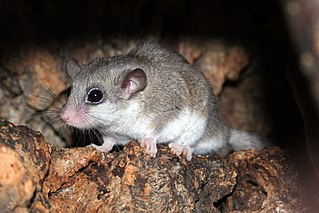
A dormouse is a rodent of the family Gliridae. Dormice are nocturnal animals found in Africa, Asia, and Europe. They are named for their long, dormant hibernation period of six months or longer.

The harvest mouse is a small rodent native to Europe and Asia. It is typically found in fields of cereal crops, such as wheat and oats, in reed beds and in other tall ground vegetation, such as long grass and hedgerows. It has reddish-brown fur with white underparts and a naked, highly prehensile tail, which it uses for climbing. It is the smallest European rodent; an adult may weigh as little as 4 grams (0.14 oz). It eats chiefly seeds and insects, but also nectar and fruit. Breeding nests are spherical constructions carefully woven from grass and attached to stems well above the ground.

The golden-brown mouse lemur, also known as the (Lac) Ravelobe mouse lemur, is part of the Cheirogaleidae family, and the smallest species of lemur. It is arboreal, nocturnal and usually social. It get its name from the color of its body. Like several other mouse lemurs, like the brown mouse lemur, it is a small primate that has a brown dorsal side and a whitish-grey for its ventral side of the body. All lemurs live in Madagascar. This species was discovered in 1994.

The genus Phenacomys is a group of North American voles. The genus name comes from the Greek for "imposter mouse."

The fox squirrel, also known as the eastern fox squirrel or Bryant's fox squirrel, is the largest species of tree squirrel native to North America. Despite the differences in size and coloration, it is sometimes mistaken for American red squirrels or eastern gray squirrels in areas where the species co-exist.

The Europeanedible dormouse or European fat dormouse is a large dormouse and one of only two living species in the genus Glis, found in most of Europe and parts of western Asia. The common name comes from the Romans, who ate them as a delicacy.

Peromyscus maniculatus is a rodent native to eastern North America. It is most commonly called the eastern deer mouse; when formerly grouped with the western deer mouse, it was referred to as the North American deermouse and is fairly widespread across most of North America east of the Mississippi River, with the major exception being the lowland southeastern United States.

The Malabar spiny dormouse is a species of muroid rodent endemic to the Western Ghats of India. It is the only extant species in the genus Platacanthomys and although resembling a dormouse, it is not closely related. About the size of a brown rat, this arboreal species lives in tree holes in dense forest habitats in a small family group. They are distinguishable from other species in the area by their bushy tuft tip to the tail and the spiny fur on the back.

The eastern pygmy possum is a diprotodont marsupial of south-eastern Australia. Occurring from southern Queensland to eastern South Australia and also Tasmania, it is found in a range of habitats, including rainforest, sclerophyll forest, woodland and heath.

The northern birch mouse is a small rodent about 5 to 8 cm long, weighing 5 to 13 g. It lives in northern Europe and Asia in forest and marsh zones.
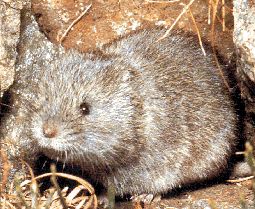
The European snow vole or snow vole is a species of rodent in the family Cricetidae. It has dense, pale grey fur and a pale-coloured tail and can reach about 14 cm (5.5 in) long, with a tail which is 7 cm (2.8 in) long.
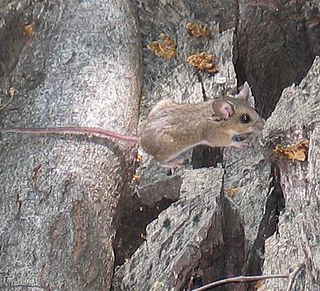
The brush mouse is a species of rodent in the family Cricetidae. It is found in mountainous areas of Mexico and the western United States at altitudes over 2,000 m (6,600 ft).
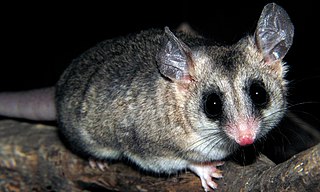
The elegant fat-tailed mouse opossum, also known as the Chilean mouse opossum, is an opossum from central Chile. The type species of Thylamys, it was first described by English naturalist George Robert Waterhouse in 1839. This medium-sized opossum is characterized by black rings around the eyes, white limbs, gray to light brown coat, lighter flanks and underbelly and a thick 12.7–14.6 centimetres (5.0–5.7 in) long tail covered with hairs. It is crepuscular and lives in nests in tree hollows or under rocks and roots. This opossum feeds mainly on arthropods and larvae apart from fruits. Litter size is typically between 11 and 13. The elegant fat-tailed opossum can occur in a variety of habitats – from cloud forests to chaparrals. The IUCN classifies the opossum as least concern.
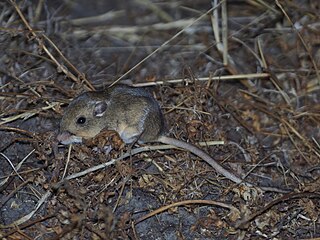
The San Joaquin pocket mouse or Salinas pocket mouse is a species of rodent in the family Heteromyidae. It is endemic to California in the United States where it lives in desert and semi-desert habitats.

Leithiinae is a subfamily of dormice. It is named after the Leithia, an extinct genus of giant dormouse from the Pleistocene of Sicily.

The forest dormouse is a species of rodent in the family Gliridae found in eastern Europe, the Balkans and parts of western Central Asia. It is categorized as being of least concern in the IUCN List of Threatened Species due to its wide range and stable population trend. Forest dormice have a diploid count (2n) of 48 chromosomes. Even though this species lives in a variety of geographic locations, its greatest population density is in the forests of central Moldova, in Transcaucasia, and in the mountains of Central Asia. In most other locations, population density of this species is rather low. Population density is dependent on many factors. But the main features that this species depends on for choosing a location are the presence of the appropriate food sources as well as good foliage that can be used for a habitat. The reason why the forests in central Moldova have the highest population density is they provide the largest diversity of food sources which are available throughout the year. This location also provides the best type of foliage for the forest dormice to build their nests as well as swing from branches. The combination of both of these aspects allows for this species to have its highest needs met. Therefore, during mating season they produce offspring who also stay in the same general area when they mature. It makes sense not to move from an area if it is providing for your most basic needs.

















